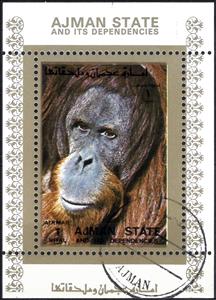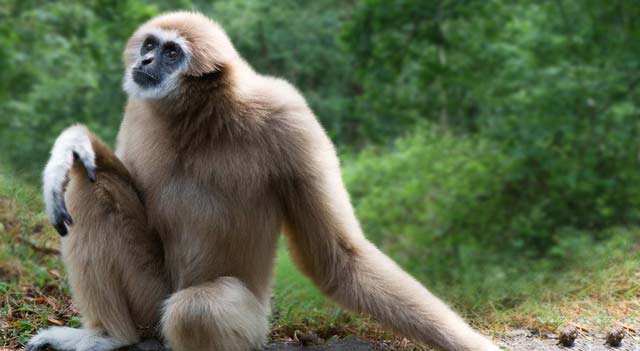Souvenir Sheet: Orangutan (Pongo spp.) (Cinderellas 1973)
Orangutan (Pongo spp.) (Cinderellas 1973)
31 March (Cinderellas ) within release Ajman State goes into circulation Souvenir Sheet Orangutan (Pongo spp.) face value 1 United Arab Emirates riyal
| Souvenir Sheet Orangutan (Pongo spp.) in catalogues | |
|---|---|
| Michel: | Mi: AJ 2830AwBL |
Souvenir Sheet is square format.
Also in the issue Ajman State:
- Souvenir Sheet - Wild Boar (Sus scrofa) face value 1;
- Souvenir Sheet - Leopard (Panthera pardus) face value 1;
- Souvenir Sheet - Animal face value 1;
- Souvenir Sheet - Lion (Panthera leo) face value 1;
- Souvenir Sheet - Animal face value 1;
- Souvenir Sheet - Arabian camel (Camelus dromedarius) face value 1;
- Souvenir Sheet - Monkeys face value 1;
- Souvenir Sheet - Animal face value 1;
- Souvenir Sheet - Tiger (Panthera tigris) face value 1;
- Souvenir Sheet - Llama (Lama glama) face value 1;
- Souvenir Sheet - Raccoon (Procyon lotor) face value 1;
- Souvenir Sheet - African Elephant (Loxodonta africana) face value 1;
- Souvenir Sheet - Animal face value 1;
- Souvenir Sheet - Roan Antelope (Hippotragus equinus) face value 1;
- Souvenir Sheet - Monkeys face value 1;
- Souvenir Sheet - Eurasian Otter (Lutra lutra) face value 1;
- Souvenir Sheet - Bisons face value 1;
- Souvenir Sheet - Animal face value 1;
- Souvenir Sheet - Sea Lion face value 1;
- Souvenir Sheet - Night Mammal face value 1;
- Souvenir Sheet - Kangaroo (Macropus spp.) face value 1;
- Souvenir Sheet - Monkeys face value 1;
- Souvenir Sheet - Monitor Lizard (Varanus spp.) face value 1;
- Souvenir Sheet - Animal face value 1;
- Souvenir Sheet - Giant Panda (Ailuropoda melanoleuca) face value 1;
- Souvenir Sheet - Leopard (Panthera pardus) face value 1;
- Souvenir Sheet - African Elephant (Loxodonta africana) face value 1;
- Souvenir Sheet - Antilope face value 1;
- Souvenir Sheet - Orangutan (Pongo spp.) face value 1;
Souvenir Sheet Orangutan (Pongo spp.) it reflects the thematic directions:
Animals are multicellular, eukaryotic organisms of the kingdom Animalia (also called Metazoa). All animals are motile, meaning they can move spontaneously and independently, at some point in their lives. Their body plan eventually becomes fixed as they develop, although some undergo a process of metamorphosis later on in their lives. All animals are heterotrophs: they must ingest other organisms or their products for sustenance.
Apes (collectively Hominoidea /hɒmɪˈnɔɪdi.ə/) are a clade of Old World simians native to sub-Saharan Africa and Southeast Asia (though they were more widespread in Africa, most of Asia, and Europe in prehistory), which together with its sister group Cercopithecidae form the catarrhine clade, cladistically making them monkeys. Apes do not have tails due to a mutation of the TBXT gene. In traditional and non-scientific use, the term ape can include tailless primates taxonomically considered Cercopithecidae (such as the Barbary ape and black ape), and is thus not equivalent to the scientific taxon Hominoidea. There are two extant branches of the superfamily Hominoidea: the gibbons, or lesser apes; and the hominids, or great apes.
Mammals are any vertebrates within the class Mammalia (/məˈmeɪli.ə/ from Latin mamma "breast"), a clade of endothermic amniotes distinguished from reptiles (including birds) by the possession of a neocortex (a region of the brain), hair, three middle ear bones and mammary glands. All female mammals nurse their young with milk, secreted from the mammary glands. Mammals include the largest animals on the planet, the great whales. The basic body type is a terrestrial quadruped, but some mammals are adapted for life at sea, in the air, in trees, underground or on two legs. The largest group of mammals, the placentals, have a placenta, which enables the feeding of the fetus during gestation. Mammals range in size from the 30–40 mm (1.2–1.6 in) bumblebee bat to the 30-meter (98 ft) blue whale. With the exception of the five species of monotreme (egg-laying mammals), all modern mammals give birth to live young. Most mammals, including the six most species-rich orders, belong to the placental group. The largest orders are the rodents, bats and Soricomorpha (shrews and allies). The next three biggest orders, depending on the biological classification scheme used, are the Primates (apes and monkeys), the Cetartiodactyla (whales and even-toed ungulates), and the Carnivora (cats, dogs, seals, and allies).



